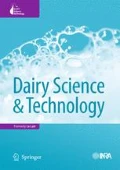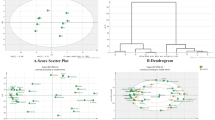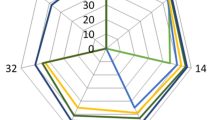Abstract
The composition of the dairy matrix used in yogurt manufacture could influence the metabolic activity of yogurt starter and the compounds produced during fermentation. In this way, the lactose hydrolysis with a β-galactosidase enzyme and the supplementation with dairy powders to obtain different types of delactosed yogurts for lactose-intolerant people modifies the milk base composition. In this work, we studied the influence of the addition of different doses of β-galactosidase and levels of dairy powders on organic acids profile during the manufacture and storage of two varieties of yogurt (natural and sweetened). Lactose, glucose, galactose, titratable acidity, fermentation time, and microbiological counts were also evaluated. The mean proportions of lactose/glucose/galactose in relation to the total sugars were 18:36:46 in hydrolyzed yogurts, while they were 81:4:15 in unhydrolyzed ones. In supplemented yogurts, the content of lactose, citric, orotic, and hippuric acids were significantly increased. The starter population was similar in all yogurts, but some changes in their activity were evidenced due to both factors studied. The fermentation time was slightly increased, and the lactic acid content and the titratable acidity were significantly increased due to fortification while they were decreased by enzyme addition. These results are probably due to the increase in the buffer properties of the milk base by the dairy powder addition and due to an inhibition of the starter activity caused by changes in the carbohydrate profile. The results demonstrated that the changes in the matrix composition of the yogurt affected the organic acids profile, above all the lactic acid content.




Similar content being viewed by others
References
Adhikari K, Grün IU, Mustapha A, Fernando LN (2002) Changes in the profile of organic acids in plain set and stirred yogurt during manufacture and refrigerated storage. J Food Qual 25:435–451
Amatayakul T, Sherkat F, Shah NP (2006) Syneresis in set yogurt as affected by EPS starter cultures and levels of solids. Int J Dairy Technol 59:216–221
Amoroso MJ, Manca de Nadra MC, Oliver G (1989) The growth and sugar utilization by Lactobacillus delbrueckii ssp. bulgaricus and Streptococcus salivarius ssp. thermophilus isolated from market yogurt. Lait 69:519–528
Baranowska M (2006) Intensification of the synthesis of flavour compounds in yogurt by milk enrichment with their precursors. Pol J Food Nutr Sci 15/51(SI 1):5–11
Birollo GA, Reinheimer JA, Vinderola CG (2000) Viability of lactic acid microflora in different types of yoghurt. Food Res Int 33:799–805
Bradley R, Arnold E, Barbano D, Semerad R, Smith D, Vines B (1992) Chemical and physical methods. In: Marshall RT (ed) Standard methods for the examination of dairy products. American Public Health Association (APHA), Washington, USA
CAA (2010) Código Alimentario Argentino. Cap VIII: Alimentos lácteos, Art 576. http://www.anmat.gov.ar/alimentos/normativas_alimentos_caa.asp. Accessed Sept 2013
Chick H, Shin HS, Ustunol Z (2001) Growth and acid production by lactic acid bacteria and bifidobacteria grown in skim milk containing honey. J Food Sci 66:478–481
Cruz AG, Castro WF, Faria JAF, Bogusz JS, Granato D, Celeguini RMS, Lima-Pallone J, Godoy HT (2012) Glucose oxidase: a potential option to decrease the oxidative stress in stirred probiotic yogurt. Food Sci Technol 47:512–515
Cruz AG, Castro WF, Faria JAF, Bolini HMA, Celeghini RMS, Raices RSL, Oliveira CAF, Freitas MQ, Conte Júnior CA, Mársico ET (2013) Stability of probiotic yogurt added with glucose oxidase in plastic materials with different permeability oxygen rates during the refrigerated storage. Food Res Int 51:723–728
Damin MR, Alcântara MR, Nunes AP, Oliveira MN (2009) Effects of milk supplementation with skim milk powder, whey protein concentrate and sodium caseinate on acidification kinetics, rheological properties and structure of nonfat stirred yogurt. LWT Food Sci Technol 42:1744–1750
Dekker PJT, Daamen CBG (2011) β-D-galactosidase. In: Fuquay J, Fox P, McSweeney P (eds) Encyclopedia of dairy science, vol 2. Academic, London
Donkor ON, Henrikssonb A, Vasiljevica T, Shah NP (2007) Proteolytic activity of dairy lactic acid bacteria and probiotics as determinant of growth and in vitro angiotensin-converting enzyme inhibitory activity in fermented milk. Lait 86:21–38
Ekinci FY, Gurel M (2008) Effect of using propionic bacteria as an adjunct culture in yogurt production. Am Dairy Sci Assoc 91:892–899
Fernandez-Garcia E, McGregor JU (1994) Determination of organic acids during fermentation and cold storage of yogurt. J Dairy Sci 77:2934–2939
Frank JF, Christen GL, Morgan S, Lynch CM, Niland EJ, Tobin J (1993)Tests for groups of microorganisms, Chap. 8. In: Marshall RT (ed) Standard methods for the examination of dairy products. American Public Health Association (APHA). Washington, USA
González de Llano D, Rodríguez A, Cuesta P (1996) Effect of lactic starter cultures on the organic acid composition of milk and cheese during ripening-analysis by HPLC. J Appl Bacteriol 80:570–576
Güler Z, Park YW (2011) Charasteristics of physico-chemical properties, volatile compounds and free fatty acid profiles of commercial set-type Turkish yoghurts. Open J Anim Sci 1:1–9
Gürakan CG, Altay N (2010) Probiotic dairy beverages: microbiology and technology. In: Yildiz F. (ed) Development and manufacture of yogurt and other functional dairy products. CRC Press, USA
Haggerty RJ, Luedecke LO, Nagel CW, Massey LK (1984) Effect of selected yogurt cultures on the concentration of orotic acid, uric acid and a hydroxymethylglutaric-like compound in milk after fermentation. J Food Sci 49:1194–1195
Hickey MW, Hillier AJ, Richard Jago G (1986) Transport and metabolism of lactose, glucose, and galactose in homofermentative lactobacilli. Appl Environ Microbiol 51:825–831
IDF (2001) Milk-determination of nitrogen content. Part 1: Kjeldahl method. IDF 20–1:2001
IDF (2005) Yogurt—determination of total solids contents (reference method). IDF 151:2005
IDF (International Dairy Federation) (2012) Fermented milks—determination of titratable acidity—potentiometric method. IDF 150:2012
Ismail AA, Mogensen G, Poulsen PR (1983) Organoleptic and physical properties of yogurt made from lactose hydrolysed milk. J Soc Dairy Technol 36:52–55
La Torre L, Tamime AY, Muir DD (2003) Rheology and sensory profiling of set-type fermented milks made with different commercial probiotic and yoghurt starter cultures. Int J Dairy Technol 56:163–170
Larson BL, Hegarty HM (1979) Orotic acid in milks of various species and commercial dairy products. J Dairy Sci 62:1641–1644
Lucas A, Sodini I, Monnet C, Jolivet P, Corrieu G (2004) Probiotic cell counts and acidification in fermented milks supplemented with milk protein hydrolysates. Int Dairy J 14:47–53
Marafon AP, Sumi A, Alcântara MR, Tamime A, Nogueira de Oliveira M (2011) Optimization of the rheological properties of probiotic yogurts supplemented with milk proteins. LWT Food Sci Technol 44:511–519
Martins AR, Monteiro RL, de Medeiros F, Burket J, Burket CAV (2012) Simultaneous enzymatic hydrolysis and lactic fermentation to obtain a yogurt with low lactose content. Ciênc Agrotecnología 36:551–559
O’Leary VS, Woychik JH (1976) Utilization of lactose, glucose, and galactose by a mixed culture of Streptococcus thermophilus and Lactobacillus bulgaricus in milk treated with lactase enzyme. Appl Environ Microb July: 89–94
Oliveira RPS, Perego P, Oliveira MN, Converti A (2012) Growth, organic acids profile and sugar metabolism of Bifidobacterium lactis in co-culture with Streptococcus thermophilus: The inulin effect. Food Res Int 48:21–27
Peng Y, Serra M, Horne DS, Lucey JA (2009) Effect of fortification with various type of milk proteins on the reological properties and permeability of nonfat set yogurt. J Food Sci 74(9):666–673
Settachaimongkon S, Nout RMJ, Antunes Fernandes EC, van Hooijdonk TCM, Zwietering MH, Smid EJ, van Valenberg HJF (2014) The impact of selected strains of probiotic bacteria on metabolite formation in set yoghurt. Int Dairy J 38:1–10
Shakeel-Ur-Rehman (2009) Lactose, water, salts and minor constituents, vol 3. In: McSweeney PLH, Fox PF (eds) Advanced dairy chemistry, 3rd edn. Springer, United States
Sieber R, Bosset JO, Bütikofer U (1995) Benzoic acid as a natural compound in cultured dairy products and cheese. Int Dairy J 5:227–246
Sodini I, Lucas A, Oliveira MN, Remeuf F, Corrieu G (2002) Effect of milk base and starter culture on acidification, textura, and probiotic cell count in fermented milk processing. J Dairy Sci 85:2479–2488
Takano T, Yamamoto N (2011) Health effects of fermented milks, vol 2. In: Fuquay J, Fox P, McSweeney P (eds) Encyclopedia of dairy science. Academic, London
Tamime AY, Robinson RK (2007) Tamime and Robinson’s yoghurt, science and technology, 3rd edn. CRC Press, USA
Toba T, Arihara K, Adachi S (1986) Quantitative changes in oligosaccharides during fermentation and storage of yogurt inoculated simultaneously with starter culture and β-galactosidase preparation. J Dairy Sci 69:1241–1245
Tormo M, Izco JM (2004) Alternative reversed-phase high-performance liquid chromatography method to analyse organic acids in dairy products. J Chromatogr A 1033:305–310
Tuure T, (2007) Lactose Intolerance: From the origin to treatment, IDF Symposium Lactose & its derivates, Moscow
Urbiene S, Leskauskaite D (2006) Formation of some organic acids during fermentation of milk. Pol J Food Nutr Sci 15:277–281
Vasilean I, Segal R (2011) The influence of biosynthesized exopolysaccharides on some characteristics of fermented dairy products. Food Technol 35(1):71–76
Zare F, Champagne CP, Simpson BK, Orsat V, Boye JI (2012) Effect of the addition of pulse ingredients to milk on acid production by probiotic and yogurt starter cultures. LWT Food Sci Technol 45:155–160
Zeppa G, Conterno L, Gerbi V (2001) Determination of organic acids, sugars, diacetyl, and acetoin in cheese by high-performance liquid chromatography. J Agric Food Chem 49:2722–2726
Zourari A, Accolas JP, Desmazeaud MJ (1992) Metabolism and biochemical characteristics of yogurt bacteria. A review. Lait 72:1–34
Acknowledgments
The authors acknowledge CONICET, for the doctoral fellowship of Claudia I. Vénica. The present work was supported by grants from Universidad Nacional del Litoral (CAI + D no. 12/Q281). The contribution made by Milkaut S.A. that provided the raw materials and other inputs for the preparation of yogurt is also acknowledged.
Author information
Authors and Affiliations
Corresponding author
About this article
Cite this article
Vénica, C.I., Perotti, M.C. & Bergamini, C.V. Organic acids profiles in lactose-hydrolyzed yogurt with different matrix composition. Dairy Sci. & Technol. 94, 561–580 (2014). https://doi.org/10.1007/s13594-014-0180-7
Received:
Revised:
Accepted:
Published:
Issue Date:
DOI: https://doi.org/10.1007/s13594-014-0180-7




